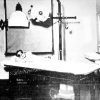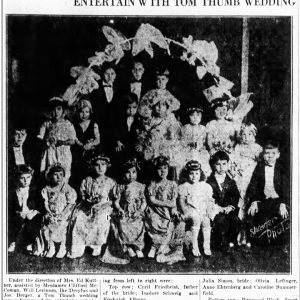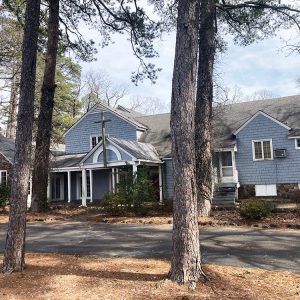calsfoundation@cals.org
Concordia Club
aka: Jewish Country Club
The first Jewish organization in Little Rock (Pulaski County) was not a congregation in a synagogue but instead was a social club. The Concordia Club was organized in 1864 by the elite of the city’s growing Jewish community. This was the first social club in Little Rock, and perhaps in the state. The purpose was to provide an organization and facilities for social activities and entertainment.
The name comes from a Latin word meaning “harmony” and “agreement.” In the religion of ancient Romans, Concordia was the goddess who embodied agreement in marriage and society.
Originally named the Little Rock Club, the organization changed its name to the Concordia Club and later to the Concordia Association; it was generally referred to as the Concordia Club. It was founded on the principle: “Pleasure is a necessary for the progress of the human race.”
There had been growth in the Jewish community in Little Rock and throughout the state during the mid-nineteenth century. The earliest Jewish immigrants in Little Rock were Reform Jews from Germany. Later immigrants were Orthodox Jews from eastern Europe, and while not initially included in the club, some did later become members.
While they were accepted and had become leaders in both business and political activity, Jews were generally not accepted by the non-Jewish social community, with the one exception of non-Jewish German immigrants, who were typically more welcoming to the Jews. The club was formed to fill the need for social outlets.
Beginning in 1866, there was discussion among club members of forming a Jewish congregation. The first religious services were held in the Concordia Club facilities. This eventually led to the founding of a congregation and establishment of the Temple B’nai Israel.
The club leased spaces in which to conduct its activities. These were second-floor spaces in buildings owned by members, and these at various times included locations on Commerce, Main, and Markham streets in downtown Little Rock. Each of its facilities was noted for size and elegance, and they were all referred to as Concordia Hall.
In 1874, the club had space at Markham and Center Streets across from what is now the Old State House. During the Brooks-Baxter War, the club’s quarters were commandeered by armed guards of the Joseph Brooks faction, who locked the members out and then used the facility as a military hospital.
The club permitted various non-Jewish groups to use its meeting halls, which enhanced relations between the communities. Some non-Jewish social clubs used the halls for events and welcomed Jewish attendees. The club’s ballroom was deemed the community’s best space to accommodate the gala celebration of the visit of former president Ulysses S. Grant in 1880.
The club’s location on East Markham was leased in 1882 in what became known as the Porbeck & Bowman Building, which went on to house various businesses. In 2009, the building became part of the Bobby L. Roberts Library of Arkansas History & Art at the Central Arkansas Library System. The library’s Concordia Hall Gallery was named in honor of the club, and there is a plaque relaying the history on the exterior of the building.
After leasing seven different locations downtown, the club built its own two-story building at 8th and Scott streets. The building was dedicated in 1903 and, after twenty-five years of use, was sold to the Boys Club in 1928.
The organization bought land southwest of the city on what was known as 19th Street Pike. Here, members built a golf course and clubhouse, and changed the organization’s name to the Concordia Country Club. Financial problems during the Great Depression in the late 1930s caused the club to close and sell the property, ending the Concordia Club’s long history.
The Jewish community organized the Westridge Country Club in 1948 and reoccupied the clubhouse on the former country club property. The members used, but did not own, their former golf course, which was adjacent and was at that time a public course. After years of activity, the club closed in 1967 due to financial considerations and availability of other options. The building was later owned by Western Hills United Methodist Church.
For additional information:
Archives of the Temple B’nai Israel, Little Rock, Arkansas.
“Concordia.” Arkansas Democrat, January 4, 1882, p. 4.
“Concordia Association.” Arkansas Gazette, April 18, 1899, p. 20.
Concordia Hall Collection. Butler Center for Arkansas Studies. Central Arkansas Library System, Little Rock, Arkansas. Finding aid online at https://cdm15728.contentdm.oclc.org/digital/collection/findingaids/id/10551/rec/1 (accessed April 30, 2024).
“Concordia’s New Home Dedicated.” Arkansas Gazette, June 9, 1903, pp. 1, 2.
Jones, Francisca. “Concordia Tells State’s Jewish History.” Arkansas Democrat-Gazette, October 24, 2020, pp. 4B, 5B.
LeMaster, Carolyn Gray. A Corner of the Tapestry: A History of the Jewish Experience in Arkansas, 1820s–1990s. Fayetteville: University of Arkansas Press, 1993.
“Social Melange.” Arkansas Gazette, November 16, 1890, p. 10.
Webb, Kane. “Forward to the Past.” Arkansas Democrat-Gazette, February 24, 2008, pp. 1J, 3J, 6J.
W. W. Satterfield
Little Rock, Arkansas


 Concordia Club Sign
Concordia Club Sign  Tom Thumb Wedding
Tom Thumb Wedding  Westridge Country Club
Westridge Country Club 



Comments
No comments on this entry yet.